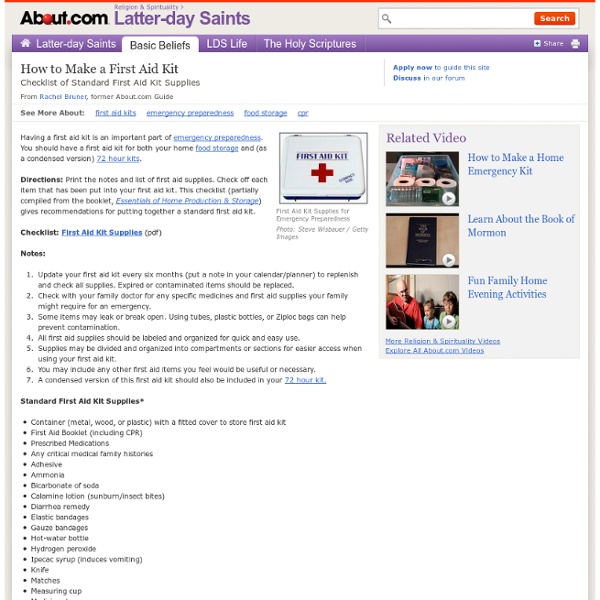First Aid Kit - How to Make a First Aid Kit
Having a first aid kit is an important part of emergency preparedness . You should have a first aid kit for both your home food storage and (as a condensed version) 72 hour kits . Directions: Print the notes and list of first aid supplies. Check off each item that has been put into your first aid kit. Checklist: First Aid Kit Supplies (pdf) Notes: Update your first aid kit every six months (put a note in your calendar/planner) to replenish and check all supplies.
Emergency Preparation - What to Take When You Escape - Preparing for an Emergency or Natural Disaster
Here's a quick list of items to take when an emergency or natural disaster strikes and you have to escape your home. Prepare for an emergency by having these items organized and easily accessible. Store what you can in water/fire safe containers. Printing this list and having it posted in an easy to find spot will help you remember what you need to take when you're panicked and can't think properly. What to Take When You Escape Your children (seriously- when you're panicked make sure you get your children to safety first!) Additional Emergency Preparation tips: Decide where you will reunite after a disaster.
72 Hour Kit
A 72 Hour Kit is essential for any emergency. Your 72 Hour Kit could mean the difference between life and death. We recommend purchasing your 72 Hour Kit only through an established and reputable company. There are many types of disasters and emergencies: floods, fires, earthquakes,hurricanes and tornadoes. in many cases, a 72 hour kit could mean the difference between life and death. 72 Hour Kit *** 72 Hour Kit Info You Need To Know *** 1) Your 72 hour kit should be in a portable container located near an exit of your house or better, sheltered in your backyard. 2) Each family member should have their own 72 hour kit with food, clothing and water. 3) Enclose the extra clothing, matches, personal documents, and other items damageable by smoke or water in plastic to protect them. 4) Keep a light source in the top of your 72 hour kit, so you can find it quickly in the dark. 5) Personalize your 72 hour kit. 6) Inspect your 72 hour kit at least twice a year.
Related:
Related:



